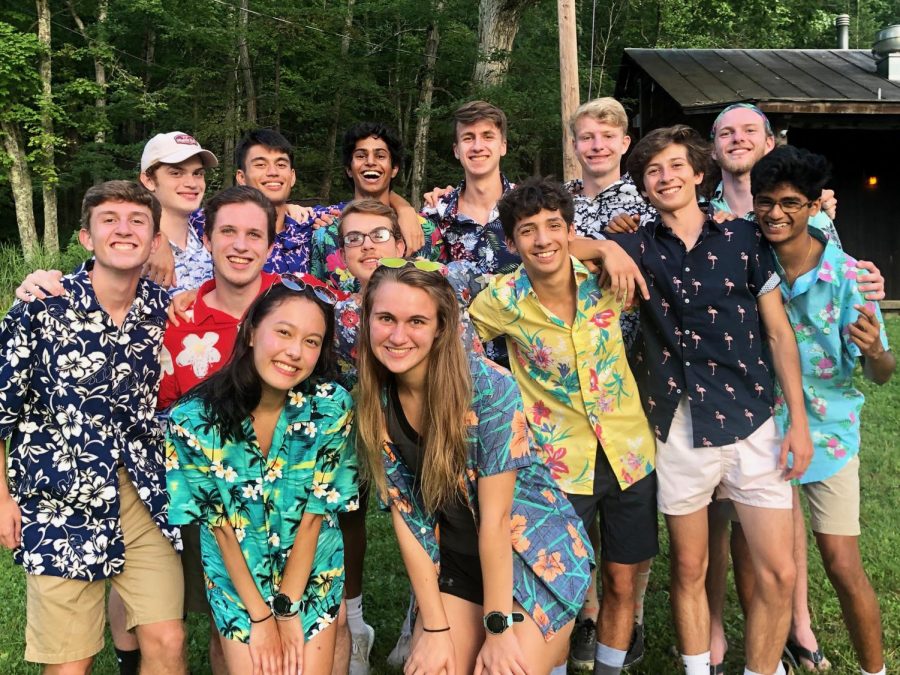Summer training jumpstarts fall sports
The cross country team’s senior class wears Hawaiian shirts at their annual cross country camp as a bonding activity. Besides the coordinated outfits, bonfires, ping pong tournaments and ice cream socials were also utilized in order to try to bring the team closer together.
September 26, 2019
Making s’mores with friends and sitting around a bonfire are almost always part of a quintessential summer camp, but what may not be as typical is running up steep hills, sprinting on the football field, or going through volleyball drills. For student athletes this summer, these activities were only some of what made up their camps and summer training in order to jumpstart their athletic season.
Conditioning is a necessity for athletes because it not only improves fitness, but also prevents injury, ensuring that teams are fully prepared for the competitive fall sports season. Several fall sports took part in preseason conditioning, taking various forms in camps, two-a-day practices and weight training.
The cross country team was able to gain a significant head start, as they began their training before last school year came to a close.
“We started training around late June,” senior and cross country captain Adam Jaynes said. “Over the summer we built up our workouts, meaning we weren’t really training at the intensity that we do during the regular season. Team wise, we were also able to get to know everyone, so the process of team bonding as well as building up our strength for the regular season was what made up our summer.”
Not only did the team have early practices, but they also were able to participate in a week-long camp in West Virginia to gain experience on a different terrain. Due to the many hills that are not commonly found near the school where they usually train, the team found it to be a challenge.
“The hardest part was definitely the ten miler, but camp was fun and a rewarding experience for everyone that was able to go,” Jaynes said.
The football team also put in work over the summer, and could frequently be seen on the field early in the morning.
“We started training around July,” junior and quarterback Jack Ready said. “In the early summer, we would show up and go outside to condition, so running and sprinting, and then we would go inside and lift. We started practice in August, and we would just go through our offense and defense routines.”
Similarly to cross country, the football team participated in camps over the summer.
“We had two camps, where we would go and scrimmage other teams, but it was also like a shortened practice,” Ready said. “It was a good opportunity for us to become accustomed to plays. My favorite part of training over the summer was just hanging out with and getting to know all the players, especially the sophomores coming up from freshman football.”
The girls’ volleyball team does not attend a camp as part of their own summer conditioning, but instead hosts a volleyball camp for girls between the ages of nine and 14.
“It is about five hours a day and completely run by players,” senior and varsity player Kristin Nivera said. “I have coached at it for two years, and there are always a lot of younger girls there, eager to learn more about volleyball. A lot of rising freshmen use it as an opportunity to meet the coaches and players and see what the program is like.”
As for volleyball’s summer training, practices began in August as soon as tryouts ended. Their conditioning began every day in the early morning, and they also participated in an afternoon or evening practice.
“Preseason definitely helped us get closer as a team. We lost a lot of players last year so the team bonding was really crucial for us,” Nivera said. “Our practices focus a lot on skill building and collaboration. Our coach added in conditioning after practice where we built [up our] strength in the weight room and worked on agility using ladders and hurdles.”
Overall, student athletes agree that not only has the work they put in during the summer been beneficial for training their bodies, but also for getting to know others on their teams.
“As a team, we benefited a lot from the bonding we were able to do, as well as getting physically stronger not just individually, but as a whole,” Jaynes said. “I think we all probably learned a lot about each other as well, and that was the best part of the summer.”


